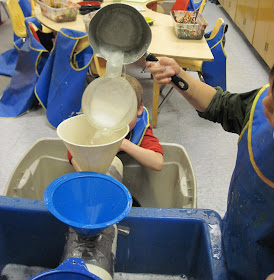Children in the process of Messing About are natural tool makers. In the following video, a child used a rock to clear the sand off of a small ledge in the sand table. In essence, the child created a rock scraper to complete her chosen task.
Rock scraper from Thomas Bedard on Vimeo.
It is fascinating to watch the fluid hand motions of the child as she used the rock scraper to try to get as much sand off of the ledge as possible.
In the second video, a child created a ramp from a piece of tree bark. He created it by turning the smooth side up and propping it on the lip of the table. He used the tree-bark ramp to test how different rocks slid down the incline.
Tree bark ramp from Thomas Bedard on Vimeo.
As the first rock slid down the ramp, it hit a little crack at the bottom of the ramp, which caused it to tumble into the table. The second rock he slid down was bigger and the little crack in the bark did not make it tumble and roll into the table. He was intrigued enough with the first two results that he continued experimenting with how other rocks slid down the tree-bark ramp.
The child pictured below used a funnel to create a tool to insure that all the sand he poured into the top funnel went into the plastic bottle on the bottom of the tub.
An interesting aspect of this exploration was that there was a slight delay from when the he poured sand into the top funnel and when it came out the bottom funnel into the clear plastic bottle. That made it quite challenging to not overfill the bottle.
The child pictured below used a pot as a tool to pour water from a plastic measuring cup into a funnel. In essence, the child used the pot to "hold" the handle of the plastic measuring cup instead of actually holding the measuring cup with his hand.
Although this may not look like what is normally considered a tool, the pot in this instance became an extension of his hand.
Creating a vacuum with a funnel from Thomas Bedard on Vimeo.
When she tried to push the funnel back into the water, again the air could not escape through the hole so it started to displace the water in the bowl making it hard for her to push the funnel to the bottom of the bowl. Leave it to a three-year-old Messing About to create a vacuum with a funnel.
The child in the video below used a clear plastic tube to create a tool to extend his reach. He did that by inserting his hand and arm as far into the tube as possible. With the tube on his hand and arm, he collected some corn from the sensory table. After collecting the corn, he reached through the window in the box to deposit the corn into the hole at the bottom of the box inside.
Making a tool to extend the hand from Thomas Bedard on Vimeo.
I recently read a story in the January/February 2019 issue of DISCOVER that made me think of this child and his tool. In the article on page 46, scientists were trying to save the northern white rhino from complete extinction. To do that, they had to build a custom probe to harvest a rhino's eggs because they were inaccessible using standard equipment. Can't you just see this child creating such a probe?
What came first: Did the children look for some thing to help with their testing or probing or did they find some thing that suggested a path to their testing and probing? Did the children even know they were making tools? What do you think?
Here is what Hawkins believes: "Children are in fact playful and eolithic, ... I use the word eolithic in memory of our remoter ancestors who had to start life with objects not intended for any purpose, but who after picking up the stone, for example, invented uses for it. The first invention was not the object --- but the purpose." (p 107 -108).


Hands and tools. Hands as tools. This post reached out to grab me Tom. I can't help but imagine how human history over time is reflected in the development of an individual child's skills. I've come to begrudgingly learn that there's no direct correlation between the development of an individual and a whole society (recapitulation theory), but didn't the child scraping sand with a rock remind you of someone (perhaps very very long ago) scraping an animal skin clean? This focus on hand-work in the most elemental sense, is sorely lacking attention in schools today. I am still plugging along with the Hawkins book by the way, it is a gift that continues to give, thank you.
ReplyDelete